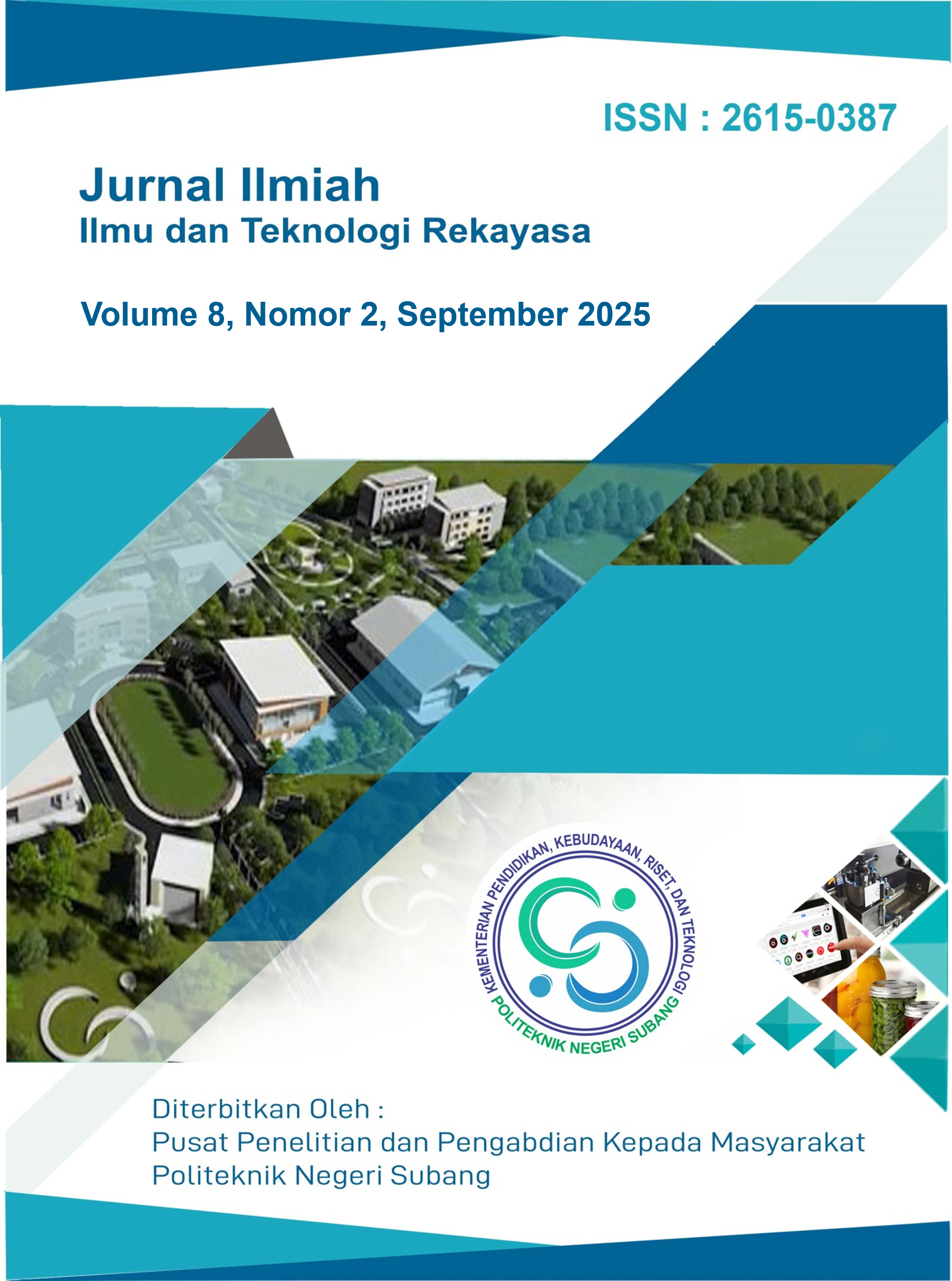Optimasi proses fermentasi limbah pertanian menjadi bioetanol sebagai energi terbarukan
Main Article Content
Abstract
Pemanfaatan limbah pertanian sebagai bahan baku energi terbarukan merupakan solusi strategis untuk mengurangi ketergantungan terhadap bahan bakar fosil. Limbah seperti jerami padi, tongkol jagung, dan kulit singkong memiliki kandungan lignoselulosa tinggi yang berpotensi diubah menjadi bioetanol melalui proses fermentasi. Penelitian ini bertujuan untuk mengoptimalkan proses fermentasi limbah pertanian menjadi bioetanol dengan variasi waktu dan konsentrasi substrat menggunakan Saccharomyces cerevisiae. Penelitian dilakukan menggunakan rancangan faktorial 3×3 dengan variasi waktu fermentasi (48, 72, 96 jam) dan konsentrasi substrat (10%, 15%, 20%). Analisis kadar bioetanol dilakukan dengan metode destilasi dan pengukuran menggunakan alkoholmeter. Hasil menunjukkan bahwa kombinasi waktu fermentasi 72 jam dan konsentrasi substrat 15% menghasilkan kadar bioetanol tertinggi sebesar 8,9% (v/v). Uji ANOVA menunjukkan adanya pengaruh signifikan interaksi waktu dan konsentrasi substrat terhadap kadar bioetanol (p<0,05). Peningkatan waktu fermentasi di atas 72 jam tidak meningkatkan kadar bioetanol secara signifikan, diduga akibat penurunan aktivitas enzimatik ragi. Hasil penelitian ini menunjukkan bahwa limbah pertanian memiliki potensi besar sebagai bahan baku bioetanol, dan optimasi proses fermentasi dapat meningkatkan efisiensi konversi biomassa menjadi energi terbarukan.
Article Details

This work is licensed under a Creative Commons Attribution 4.0 International License.
References
Balat, M. and Balat, H. (2009) ‘Recent trends in global production and utilization of bio-ethanol fuel’, Applied Energy, 86(11), pp. 2273–2282.
Balat, M. (2011) ‘Production of bioethanol from lignocellulosic materials via the biochemical pathway’, Energy Conversion and Management, 52(2), pp. 858–875.
Cardona, C.A. and Sánchez, Ó.J. (2007) ‘Fuel ethanol production: process design trends and integration opportunities’, Bioresource Technology, 98(12), pp. 2415–2457.
Gnansounou, E. et al. (2009) ‘Life cycle assessment of bioethanol production from agricultural residues’, Renewable Energy, 34(6), pp. 1793–1801.
Hamelinck, C.N. et al. (2005) ‘Ethanol from lignocellulosic biomass: techno-economic performance in short-, middle- and long-term’, Biomass and Bioenergy, 28(4), pp. 384–410.
Kumar, A. et al. (2016) ‘Optimization of bioethanol production from agro-wastes’, Renewable Energy, 86, pp. 965–972.
Lee, J. (1997) ‘Biological conversion of lignocellulosic biomass to ethanol’, Journal of Biotechnology, 56(1), pp. 1–24.
Lin, Y. and Tanaka, S. (2006) ‘Ethanol fermentation from biomass resources: current state and prospects’, Applied Microbiology and Biotechnology, 69(6), pp. 627–642.
Mussatto, S.I. et al. (2010) ‘Technological trends, global market, and challenges of bio-ethanol production’, Biotechnology Advances, 28(6), pp. 817–830.
Sánchez, Ó.J. and Cardona, C.A. (2008) ‘Trends in biotechnological production of fuel ethanol from different feedstocks’, Bioresource Technology, 99(13), pp. 5270–5295.
Sun, Y. and Cheng, J. (2002) ‘Hydrolysis of lignocellulosic materials for ethanol production’, Bioresource Technology, 83(1), pp. 1–11.
Taherzadeh, M.J. and Karimi, K. (2007) ‘Acid-based hydrolysis processes for ethanol from lignocellulosic materials: a review’, BioResources, 2(3), pp. 472–499.
Zabed, H. et al. (2017) ‘Bioethanol production from renewable sources: Current perspectives and technological progress’, Renewable and Sustainable Energy Reviews, 71, pp. 475–501.
Zhao, X. et al. (2012) ‘Challenges and opportunities in lignocellulosic bioethanol production’, Applied Microbiology and Biotechnology, 95(3), pp. 661–672.
Huang, H. et al. (2015) ‘Improvement of ethanol production from corn stover hydrolysate by fed-batch fermentation’, Bioresource Technology, 177, pp. 147–153.
Kim, S. and Dale, B.E. (2004) ‘Global potential bioethanol production from wasted crops and crop residues’, Biomass and Bioenergy, 26(4), pp. 361–375.
Pandey, A. et al. (2011) Biofuels: Alternative feedstocks and conversion processes. London: Academic Press.
Sarkar, N. et al. (2012) ‘Bioethanol production from agricultural wastes: An overview’, Renewable Energy, 37(1), pp. 19–27.
Sukumaran, R.K. et al. (2010) ‘Enzymatic hydrolysis of lignocellulosic biomass’, BioResources, 5(2), pp. 919–944.
Zheng, Y. et al. (2009) ‘Improving ethanol yield by fed-batch fermentation using mixed feedstocks’, Biochemical Engineering Journal, 46(2), pp. 140–145.
IEA (2022) Renewables 2022 Report. Paris: International Energy Agency
